
How Zapier unified buying signals to increase meetings booked by 31% in 3 months
"Reaching the right stakeholders is critical to building a repeatable sales motion and increasing ACVs. Our teams had to jump back and forth between multiple tools to do that, and we were still missing key insights. With Common Room, we can identify the right stakeholders faster."

Nalin Vahil
VP of Sales and Customer Success
Business model
- Product-led
- Sales-led
- Enterprise
Teams
- AMs
- AEs
- CSMs
- RevOps
- Demand Gen
- MarketingOps
Use cases
- Unified customer view
- Product activity tracking
- Job-change tracking
- GTM workbench
- Workflow automation
Key signals
- Summary
- Key quotes
- Background
- Centralize siloed data
- Surface the right personas automatically
- Run proven plays at scale
- Results
Turn buyer intelligence into pipeline with AI.
Request demoSummary
How Zapier runs go-to-market intelligentlyAbout Zapier
Zapier is a workflow automation platform used by millions of customers worldwide, from teams of one to massive enterprise organizations.
Problem
Zapier needed go-to-market team members to use product usage data and other buying signals to identify and engage the right stakeholders in order to increase annual contract values. But team members had to jump back and forth between four separate tools to surface the information they needed to pinpoint stakeholders and craft outreach. Teams were missing key details that would help them prioritize the right accounts and manual processes made it impossible to scale plays across the team.
Solution
Zapier turned Common Room into a single source of truth for all GTM teams. Instead of switching between interfaces and hunting for relevant info, team members are automatically served up every meaningful buying signal—connected to real people and real accounts—in one place, allowing them to build, test, and iterate on winnings plays quickly and scalably.
Strategy
Zapier uses digital signal capture, unified identity and account intelligence, and AI-powered automations to automatically spotlight the right stakeholders and auto-populate buyer segments for different plays, from upsell opportunities to account consolidations.
Results
Common Room generated:
- 31% increase in total meetings booked within three months
- 62% of meetings booked by AMs
- 41% of total pipeline generated by AMs
- 24% of closed-won deals sourced by AMs
Key quotes

“Common Room gives me a view of all the important contacts at one company. All the info I need is all in one place and easy to sort through. It helps me find important contacts to outreach, understand who they are, and prioritize who’s most relevant.”

Cathy Du
Strategic Account Manager

“Common Room eliminates the guesswork. We can quickly see what’s going on with all our accounts, as well as what each person within an account is doing and saying across channels. Whether you’re trying to identify upsell opportunities or prevent churn, that’s huge.”

Jordan Vash
Sales Manager

“Every distraction is a productivity killer. The more time teams spend hopping back and forth between interfaces, the less time they spend generating pipeline. Common Room helps our customer-facing teams focus on what really matters: delivering value and driving revenue.”

Nalin Vahil
VP of Sales and Customer Success
Background
Customer data is a lot like a treasure map—incredibly valuable but completely useless if you can’t take action on it. It’s a problem go-to-market teams are all too familiar with, from pre-sales to post-sales.
That’s why data-driven organizations like Zapier are spending less time poring over siloed data points and more time turning buyer behaviors and characteristics into actionable intelligence.
Here’s how Zapier used Common Room to:
- Replace multiple point solutions with one source of truth
- Help GTM teams reach the right stakeholders with the right message at the right time
- Increase total meetings booked by 31% in three months
Centralize siloed data
Product-led growth (PLG) has been Zapier’s bread and butter from the very beginning. And while its self-service motion generates lots of inbound leads, it also creates complexities for the teams responsible for making sure free trialists turn into paying accounts that continue to grow over time.
Account executives and account managers were spending too much time jumping between multiple tools to identify high-value accounts, product usage trends, and engagement activity outside of the product.
Best-case scenario: Team members would switch back and forth between tools to surface priority accounts and sort them based on user permissions and product usage. Then they’d manually research people on LinkedIn to find likely prospects and craft personalized messages.
But more often than not, team members would default to sending scaled sequences to whoever was listed as an admin or active user. This made building successful, scalable sales motions next to impossible.
Zapier uses Common Room to capture and unify all relevant signals—such as product usage, CRM records, social engagements, and customer support messages—in one place and automatically enrich them using AI. This provides go-to-market teams across sales, customer success, and beyond with a 360-degree view of the people and organizations active across Zapier’s digital ecosystem.

Common Room’s integrations with dozens of data sources—including popular digital channels, CRMs, data warehouses, sales engagement platforms, and more—allow you to organize and access all your data in one place. This makes it easy to take action on buying signals fast.
After RevOps, Demand Gen, and MarketingOps identify which signals they want to pull into the platform, Common Room’s proprietary identity resolution and enrichment engine, Person360™, uses machine learning to transform fragmented data points into the insights sales and success teams need, including contact information, job history, firmographic fit, cross-channel activity, and much more.
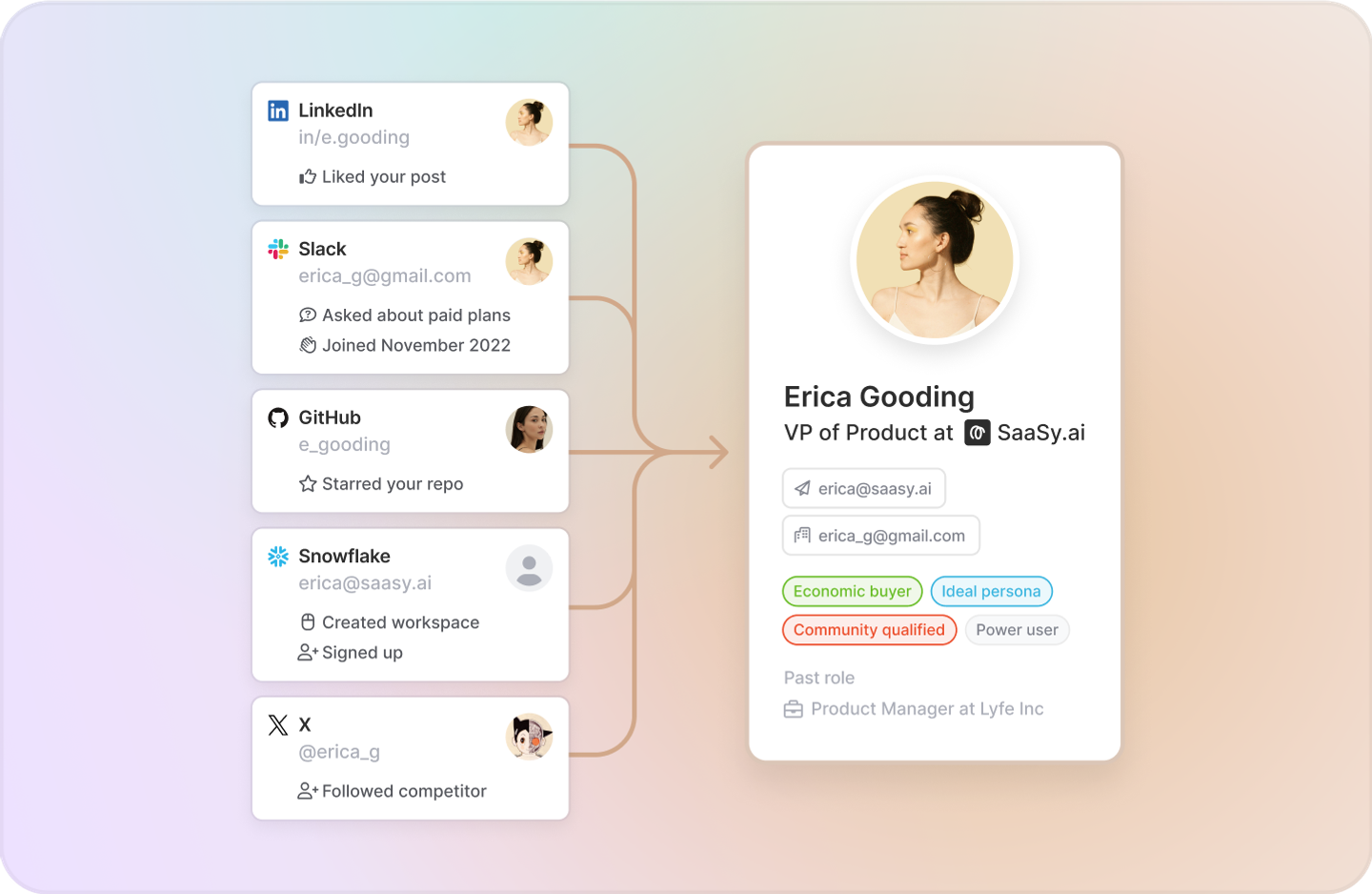
Common Room’s Person360 feature allows you to automatically collect, deanonymize, enrich, and match signals to a unified profile for individuals and organizations. This makes it easy to connect with the people and companies behind buying signals with full context.
“Common Room gives me a view of all the important contacts at one company,” said Strategic Account Manager Cathy Du. “All the info I need is all in one place and easy to sort through. It helps me find important contacts to outreach, understand who they are, and prioritize who’s most relevant.”
Surface the right personas automatically
Not all product sign-ups are created equal. Zapier uses Common Room to help its GTM org focus on high-value, high-seniority prospects and customers.
While director-level stakeholders and above account for a smaller percentage of Zapier’s lead volume, they’re responsible for a majority of overall revenue. Using Common Room, teams can surface these individuals on autopilot.
"Reaching the right stakeholders is critical to building a repeatable sales motion and increasing ACVs,” said Vice President of Sales and Customer Success Nalin Vahil. “Our teams had to jump back and forth between multiple tools to do that, and we were still missing key insights. With Common Room, we can identify the right stakeholders faster."
User-friendly filters and tags make it easy to create auto-replenishing segments for target accounts. In the case of Zapier, that means any person who matches the criteria for an economic buyer is automatically added to a rep’s segment. In this way, Common Room serves up fresh, high-quality leads on a daily basis.
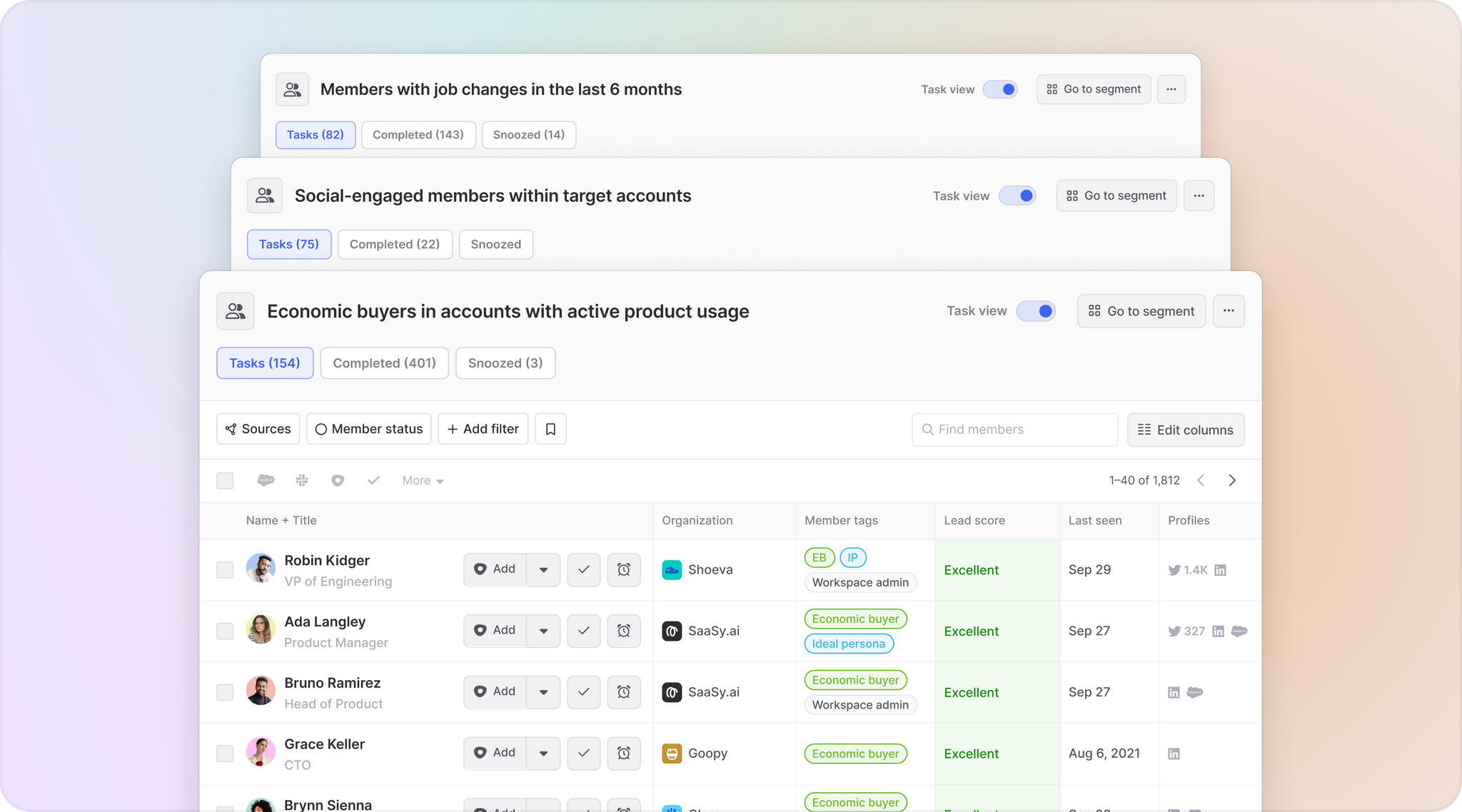
Common Room’s segments feature allows you to automatically add individuals or organizations to auto-replenishing lists based on customizable criteria. This makes it easy to quickly surface, monitor, and engage specific people and companies at scale.
Meanwhile, real-time alerts ensure team members are notified the instant a new lead is added to their segment so they can follow up fast.
Team alertsCommon Room’s team alerts feature allows you to automate alerts based on any combination of triggers and filters so you can see real-time activity from the people and accounts you care about. This makes it easy to always stay updated on specific individuals and organizations.
And if reps come across a high-fit account with no visible decision-maker, they can use Common Room's Prospector feature to instantly pull up a list of all economic buyers at the company and add them as contacts.
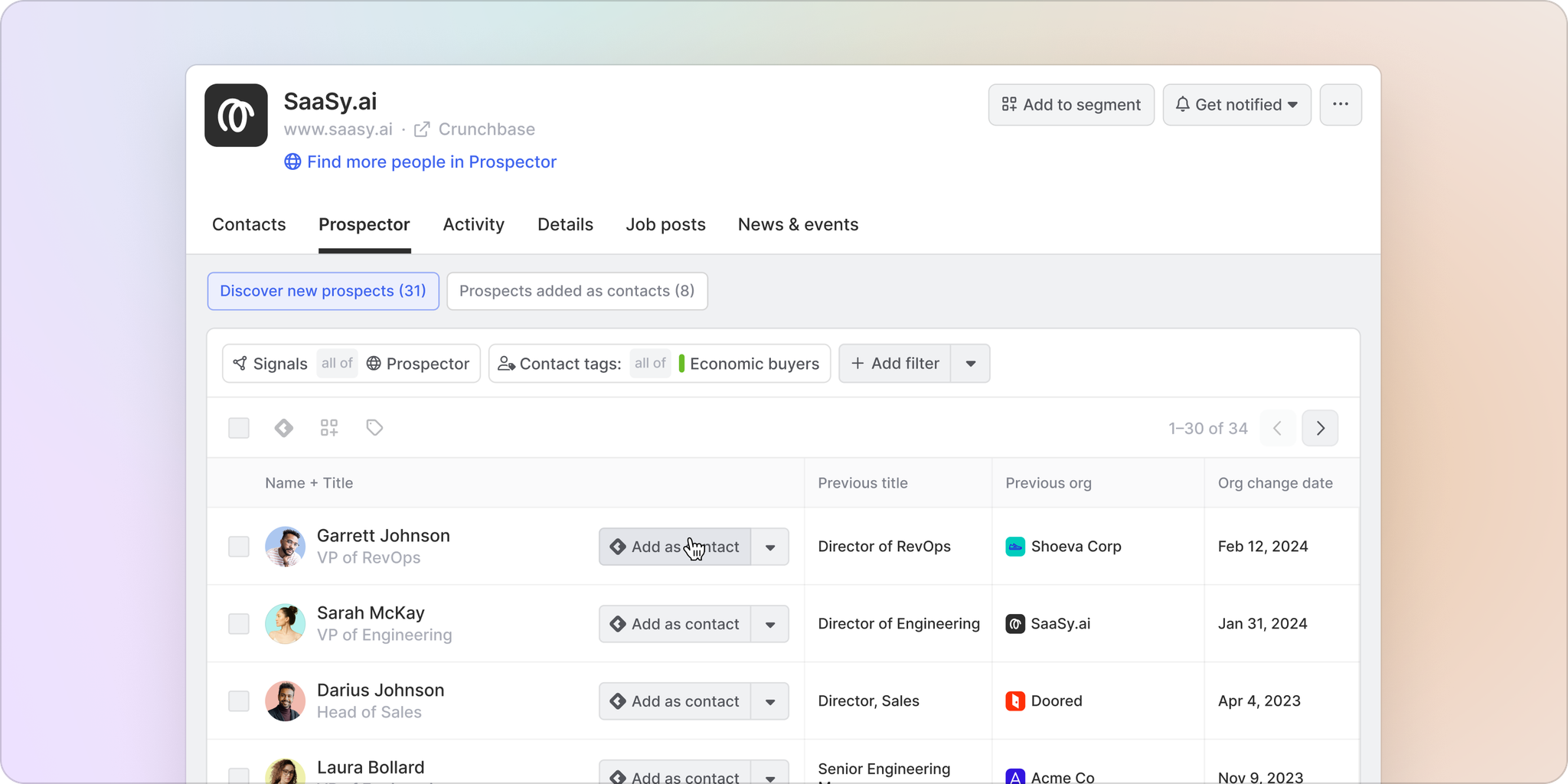
Common Room’s Prospector feature allows you to search through a proprietary, constantly refreshed database of more than 200 million B2B contacts, surface employees at specific organizations, and add them as contacts—even if they’re not currently engaging with your organization on any connected channels or tracked in your CRM.
AEs, AMs, and CSMs alike use segments and alerts to monitor their books of business, prioritize high-value accounts for acquisition, expansion, and retention plays, and uncover multithreading opportunities within different accounts. In fact, Zapier found that pulling in signals from multiple sources increased its potential reach at named accounts by 15%.
“Common Room eliminates the guesswork,” said Sales Manager Jordan Vash. “We can quickly see what’s going on with all our accounts, as well as what each person within an account is doing and saying across channels. Whether you’re trying to identify upsell opportunities or prevent churn, that’s huge.”
Run proven plays at scale
Common Room gives Zapier’s GTM org the ability to launch, test, and automate plays that drive revenue—quickly and consistently. This most often takes the form of identifying net new opportunities among existing customers across named and unnamed accounts.
For example, AMs can create segments for high-spend named accounts specific to their books of business in their CRM (HubSpot, in Zapier’s case) and quickly create a list of ideal personas who are not currently active in the product. This helps them find upsell opportunities.
TagsCommon Room’s tags feature allows you to automatically label individuals and organizations with specific tags based on customizable criteria. This makes it easy to quickly filter for ideal personas, ideal customer profiles, and more.
At the same time, they can create separate segments for unnamed accounts where active product users are engaging with the company across social channels. Since it’s quite common for organizations to have multiple low-paying product accounts active across different teams, AMs can quickly get a consolidation conversation off the ground and turn low-spend users into enterprise customers.
Custom product entitiesCommon Room’s custom product entities feature allows you to customize how product usage data is ingested so it’s always displayed in the way you want to see it. This makes it easy to tailor visibility into how users and accounts are behaving inside a product.
From the number of paid accounts within an organization to top product use cases, teams can slice and dice data to create any number of granular plays. Each of these plays can then be automated end to end—from signal capture to identity resolution to engagement—with Common Room’s user-friendly workflow builder.
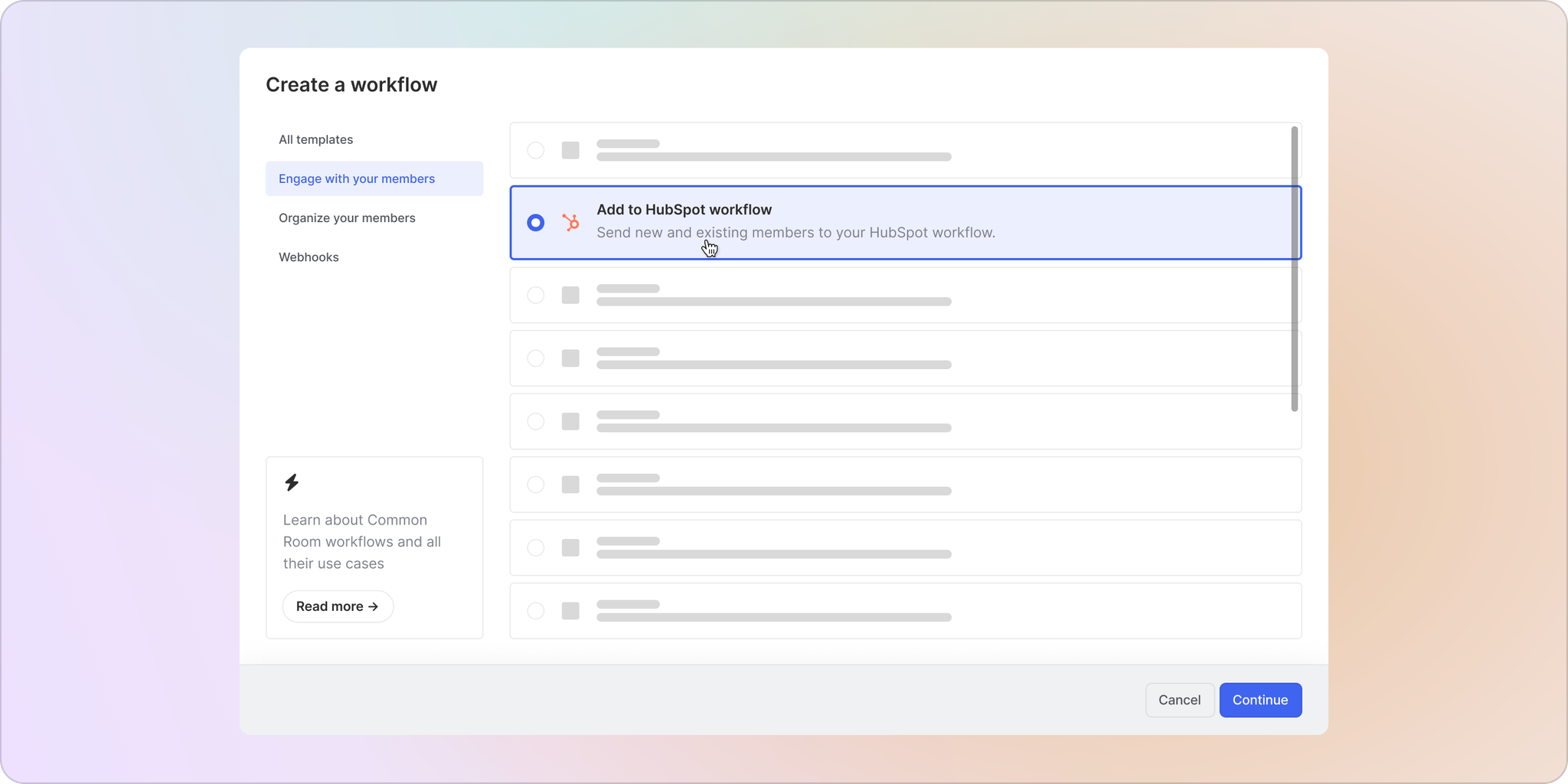
Common Room’s workflows feature allows you to create and customize automations based on specific demographic, firmographic, and activity details. This makes it easy to quickly and scalably track, organize, and engage people and accounts.
While product-led inbound leads are the core foundation of Zapier’s GTM strategy, the company is also starting to build out its outbound motion using the out-of-the-box signals available in Common Room. Job changes, news events, hiring trends—all these and more help reps zero in on high-fit accounts that are in-market and allow them to craft relevant messaging.
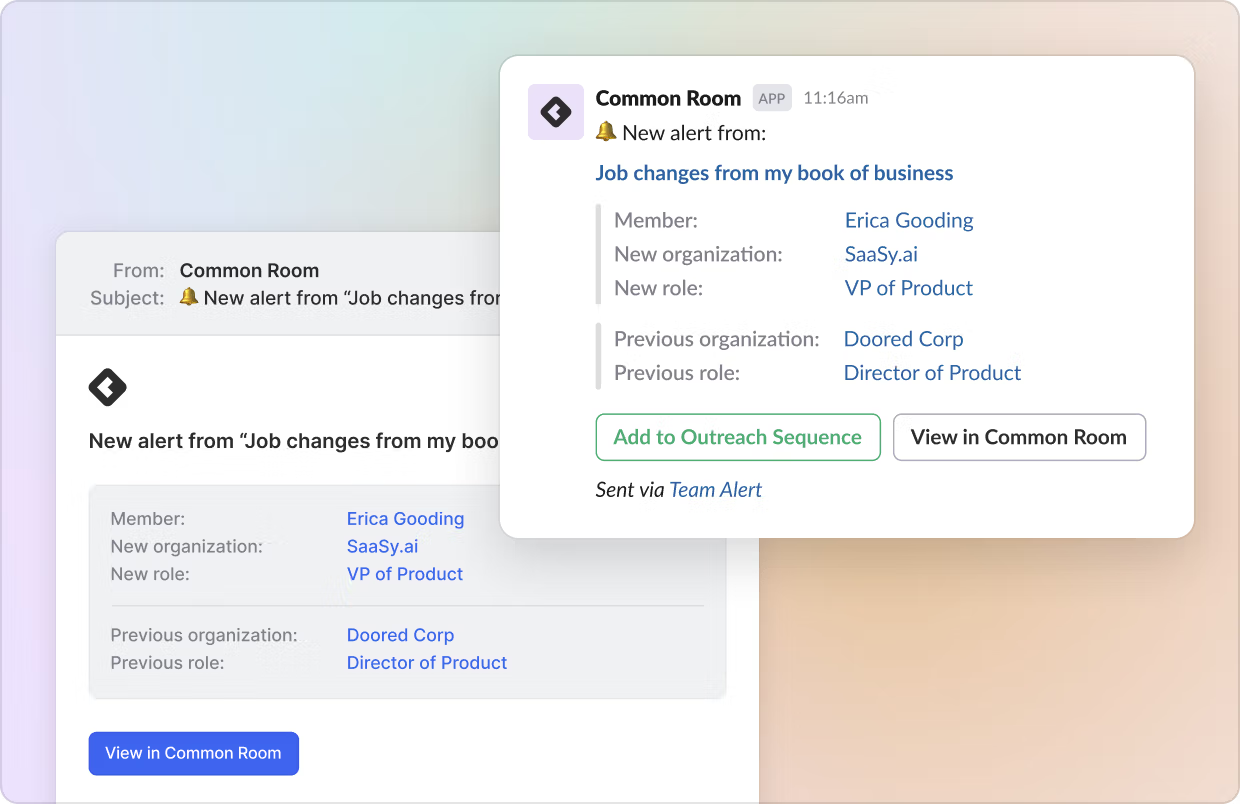
Plus, with Common Room’s AI-powered account research, sales reps can instantly get a handle on any target account’s products, customers, competitors, and more—no screen switching or manual research necessary.
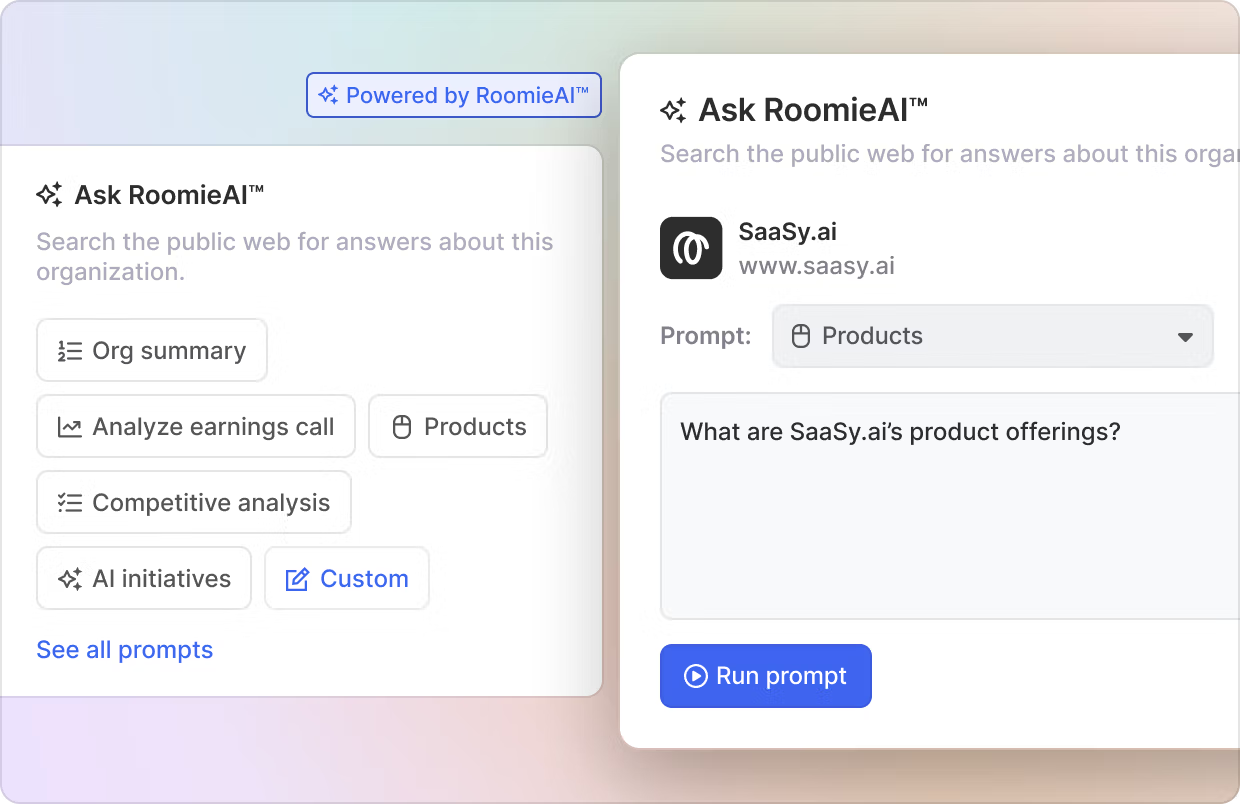
Common Room’s RoomieAI—a suite of AI-powered tools specially designed for go-to-market teams—allows you to augment your day-to-day workflows to boost productivity. This makes it easy to summarize account research in an instant, create LLM-generated outbound snippets based on every available signal, and much more.
“Every distraction is a productivity killer,” Nalin said. “The more time teams spend hopping back and forth between interfaces, the less time they spend generating pipeline. Common Room helps our customer-facing teams focus on what really matters: delivering value and driving revenue.”
Results
Zapier’s primary use case so far has been expanding and consolidating existing customer accounts.
From March 2024 to June 2024, Common Room directly contributed to:
- 62% of meetings booked by AMs
- 41% of pipeline generated by AMs
- 24% of closed-won deals sourced by AMs
And in the three months since adopting Common Room, Zapier has increased its total number of meetings booked by 31% company-wide.
Zapier helps its customers automate manual processes so they can accomplish more with less work. Common Room helps Zapier with the very same thing.
Tap into the power of customer intelligence with Common Room
We think you'd like these
How Airbyte built a warm outbound motion to 2x its year-over-year pipeline growth rate
2x+ YoY pipeline growth rate
See how Airbyte used Common Room to exceed its annual pipeline targets in half the time.Read full storyHow incident.io upgraded from legacy prospecting tools to boost pipegen performance
2x faster pipegen
See how incident.io used Common Room to generate more meetings booked in much less time.Read full storyHow Homebot used AI agents to generate $1.5M in new pipeline in a single month
250% ROI
See how Homebot used Common Room to generate $1.5 million in new pipeline in one month.Read full story
